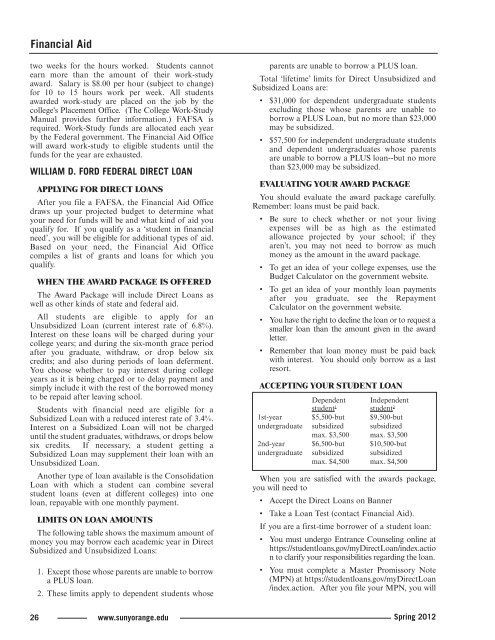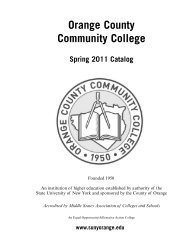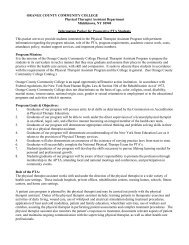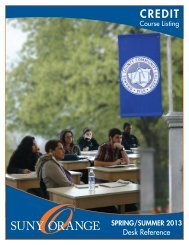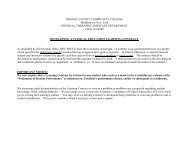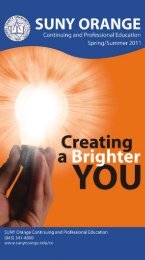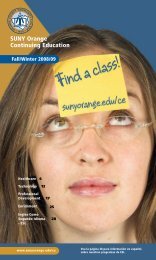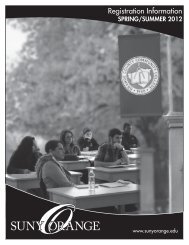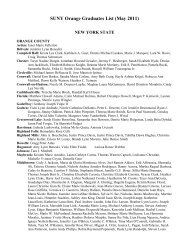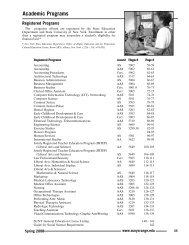Indexed Adobe PDF (Spring 2012 - Full Version) - SUNY Orange
Indexed Adobe PDF (Spring 2012 - Full Version) - SUNY Orange
Indexed Adobe PDF (Spring 2012 - Full Version) - SUNY Orange
You also want an ePaper? Increase the reach of your titles
YUMPU automatically turns print PDFs into web optimized ePapers that Google loves.
Financial Aid<br />
two weeks for the hours worked. Students cannot<br />
earn more than the amount of their work-study<br />
award. Salary is $8.00 per hour (subject to change)<br />
for 10 to 15 hours work per week. All students<br />
awarded work-study are placed on the job by the<br />
college's Placement Office. (The College Work-Study<br />
Manual provides further information.) FAFSA is<br />
required. Work-Study funds are allocated each year<br />
by the Federal government. The Financial Aid Office<br />
will award work-study to eligible students until the<br />
funds for the year are exhausted.<br />
WILLIAM D. FORD FEDERAL DIRECT LOAN<br />
APPLYING FOR DIRECT LOANS<br />
After you file a FAFSA, the Financial Aid Office<br />
draws up your projected budget to determine what<br />
your need for funds will be and what kind of aid you<br />
qualify for. If you qualify as a ‘student in financial<br />
need’, you will be eligible for additional types of aid.<br />
Based on your need, the Financial Aid Office<br />
compiles a list of grants and loans for which you<br />
qualify.<br />
WHEN THE AWARD PACKAGE IS OFFERED<br />
The Award Package will include Direct Loans as<br />
well as other kinds of state and federal aid.<br />
All students are eligible to apply for an<br />
Unsubsidized Loan (current interest rate of 6.8%).<br />
Interest on these loans will be charged during your<br />
college years; and during the six-month grace period<br />
after you graduate, withdraw, or drop below six<br />
credits; and also during periods of loan deferment.<br />
You choose whether to pay interest during college<br />
years as it is being charged or to delay payment and<br />
simply include it with the rest of the borrowed money<br />
to be repaid after leaving school.<br />
Students with financial need are eligible for a<br />
Subsidized Loan with a reduced interest rate of 3.4%.<br />
Interest on a Subsidized Loan will not be charged<br />
until the student graduates, withdraws, or drops below<br />
six credits. If necessary, a student getting a<br />
Subsidized Loan may supplement their loan with an<br />
Unsubsidized Loan.<br />
Another type of loan available is the Consolidation<br />
Loan with which a student can combine several<br />
student loans (even at different colleges) into one<br />
loan, repayable with one monthly payment.<br />
LIMITS ON LOAN AMOUNTS<br />
The following table shows the maximum amount of<br />
money you may borrow each academic year in Direct<br />
Subsidized and Unsubsidized Loans:<br />
1. Except those whose parents are unable to borrow<br />
a PLUS loan.<br />
2. These limits apply to dependent students whose<br />
parents are unable to borrow a PLUS loan.<br />
Total ‘lifetime’ limits for Direct Unsubsidized and<br />
Subsidized Loans are:<br />
• $31,000 for dependent undergraduate students<br />
excluding those whose parents are unable to<br />
borrow a PLUS Loan, but no more than $23,000<br />
may be subsidized.<br />
• $57,500 for independent undergraduate students<br />
and dependent undergraduates whose parents<br />
are unable to borrow a PLUS loan--but no more<br />
than $23,000 may be subsidized.<br />
EVALUATING YOUR AWARD PACKAGE<br />
You should evaluate the award package carefully.<br />
Remember: loans must be paid back.<br />
• Be sure to check whether or not your living<br />
expenses will be as high as the estimated<br />
allowance projected by your school; if they<br />
aren’t, you may not need to borrow as much<br />
money as the amount in the award package.<br />
• To get an idea of your college expenses, use the<br />
Budget Calculator on the government website.<br />
• To get an idea of your monthly loan payments<br />
after you graduate, see the Repayment<br />
Calculator on the government website.<br />
• You have the right to decline the loan or to request a<br />
smaller loan than the amount given in the award<br />
letter.<br />
• Remember that loan money must be paid back<br />
with interest. You should only borrow as a last<br />
resort.<br />
ACCEPTING YOUR STUDENT LOAN<br />
Dependent Independent<br />
student 1 student 2<br />
1st-year $5,500-but $9,500-but<br />
undergraduate subsidized subsidized<br />
max. $3,500 max. $3,500<br />
2nd-year $6,500-but $10,500-but<br />
undergraduate subsidized subsidized<br />
max. $4,500 max. $4,500<br />
When you are satisfied with the awards package,<br />
you will need to<br />
• Accept the Direct Loans on Banner<br />
• Take a Loan Test (contact Financial Aid).<br />
If you are a first-time borrower of a student loan:<br />
• You must undergo Entrance Counseling online at<br />
https://studentloans.gov/myDirectLoan/index.actio<br />
n to clarify your responsibilities regarding the loan.<br />
• You must complete a Master Promissory Note<br />
(MPN) at https://studentloans.gov/myDirectLoan<br />
/index.action. After you file your MPN, you will<br />
26 www.sunyorange.edu <strong>Spring</strong> <strong>2012</strong>


